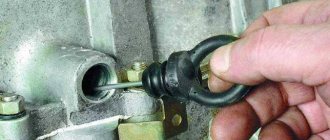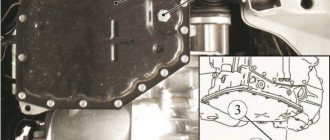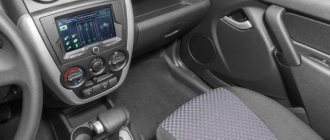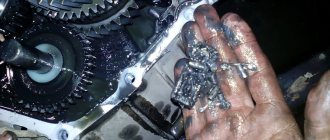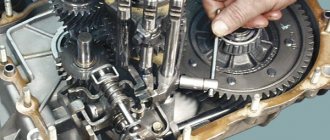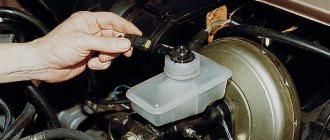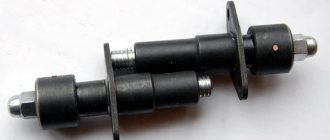Which gearbox is suitable for Kalina
The 5-speed manual transmission VAZ 1118 or the Lada Kalina gearbox was produced from 2004 to 2013 and only the AvtoVAZ model of the same name was installed in sedan, hatchback and station wagon bodies. This transmission with rigid traction control is designed for torque up to 145 Nm.
The transition family also includes 5-speed manual transmissions: 2170 and 2190.
What did you get?
The design of the gearbox was not only optimized and made more reliable, but also almost completely eliminated unpleasant vibrations on the lever and the car body. The backlash has become smaller and the shifts are clearer. It is worth noting that the use of a modernized gearbox on the Lada Granta and Lada Kalina 2 entailed an increase in the cost of these cars by an average of 5,000 rubles. By the way, the cable box is not installed on the Lada Priora; this car uses a 2180 manual transmission with rigid rods.
Let us remind you that according to reviews, the first copies of the modified gearbox were not entirely successful. The owners noticed a decrease in vibrations, but encountered a new problem: the box began to howl. After this, AVTOVAZ made changes to the design, but the sediment remained...
Source
Technical characteristics of the VAZ 1118 gearbox
| Type | Mechanics |
| Number of gears | 5 |
| For drive | front |
| Engine capacity | up to 1.6 liters |
| Torque | up to 145 Nm |
| What kind of oil to pour | Lukoil TM-4 75W-90 GL-4 |
| Lubricant volume | 3.3 liters |
| Change of oil | once every 75,000 km |
| Replacing the filter | every 75,000 km |
| Approximate resource | 150,000 km |
Design features of Kalina with automatic transmission
Lada Kalina cars, which have a 16-valve petrol engine with a volume of 1.6 liters, are equipped with an automatic transmission. The remaining models still have a manual transmission.
The structural replacement of a manual transmission with an automatic transmission led to the fact that the car began to differ in a number of features:
- the ground clearance decreased by several centimeters;
- management has become tougher;
- acceleration slowed down;
- fuel consumption increased;
- the engine is covered with an aluminum pan and is susceptible to corrosion (so it’s better to immediately think about protecting it);
- significant weight has been added.
All this is a kind of payment for comfortable driving. Some companies propose to change the design of the automatic transmission and bring it to a sports class. This changes the operation of the entire transmission, and the car becomes very noisy.
Disadvantages, breakdowns and problems of the Lada Kalina box
The reliability of this transmission is low, as is its performance characteristics
Owners complain about howling gearboxes, unclear shifts and rattling levers
The control drive and the manual transmission clutch require periodic adjustment.
Even at low mileage, progressive oil leaks from the oil seals may begin.
Bearings, gears and synchronizers have a short service life in mechanics.
You can contact the site administrator by email:
All texts were written by me, are authored by Google, included in the original Yandex texts and notarized. For any borrowing, we immediately write an official letter on company letterhead in support of search networks, your hosting and domain registrar.
Next we go to court. Don’t try your luck, we have more than thirty successful Internet projects and have already won a dozen lawsuits.
The first eights rolled off the assembly line back in 1984. These machines were equipped with two-shaft gearboxes combined in one housing with a differential. Since then, the gearbox has been repeatedly modernized, however, on all front-wheel drive VAZs, in principle, the same eight-wheel box is installed. But due to some design changes, they are not completely interchangeable. Therefore, let's look at all the variety that has been released over the past 30 years and what can be put where. The first VAZ 2108 and VAZ 2109 were equipped with 4 and 5-speed gearboxes without a dipstick. Now there are almost no such boxes left. The main pairs 4.1 and 3.9 were installed in 4 mortars. In five-speed gears 3.9 and 3.7. I want to warn you, if anyone decides to buy this type of 5-mortar from disassembly on the cheap, be careful - there are practically no normal ones. As a rule, they are worn to the limit, and almost all have buzzing 5th gears. In the 90s, these gearboxes were replaced by a five-speed gearbox with a dipstick. And since then, exclusively 5-speed ones with a dipstick have been produced. With the exception of the completely new “cable” ones, which do not have a dipstick. AvtoVAZ decided not to spoil the variety of choices and began to use only one main pair - 3.7. Well, the gear ratios of the box itself were and remain to this day only the same for all cars. The VAZ 2109 gearbox with a dipstick and the VAZ 2108 gearbox without are completely identical when installed on the car, the only differences are in the housing itself. The body parts are not interchangeable, but the internal parts are the same. These gearboxes are installed on VAZ 2108, 2109, 2113, 2114, 2115 cars produced before 2010. Pay attention to the starter mounting: 3 studs with the front starter bearing in the clutch housing (bell housing). They are not suitable for other VAZ models because they do not fit on the enlarged flywheel. In addition, on the VAZ 2110 from the very first years of production, gearboxes were installed that looked the same. The difference was in the gear selection mechanism, clutch fork and brackets. You can install these boxes on those dozens without any problems, you just need to change the fork, brackets, everything is outside and can be changed in a few minutes. But on the contrary, it is impossible to install such tenth gearboxes on a VAZ 2109-15, if you install the first gear it will be confused with the reverse one, because there is no lock in the selection mechanism. On later dozens, flywheels of increased diameter began to be installed, so these boxes are not suitable; a gearbox with a slightly increased inner diameter of the bell was released for them.
Then we got Priora and Kalina. On all the boxes listed above, the speedometer was driven using plastic gears installed in the box. On Priora VAZ 2170 cars, an electronic speedometer drive was used and a Kalinovsky bell was installed, in which the reaction rod is fastened with thicker bolts. These bells are interchangeable with decimal bells (if the gearbox is supposed to be installed on a 10 or Priora). For Kalina, you only need a Kalinovsky bell; it has three threaded holes for attaching the rear support. Electronic speedometer sensors can be of two types: black Kalinovsky and gray Priorovsky. They work exactly the same, only they work correctly if a black sensor is installed to the black ring on the differential, and, accordingly, also with a gray one. That is, when replacing, the sensor is replaced with the same one. Sometimes I've seen ten boxes installed on Prioras. At the same time, the contact block of the speedometer sensor is remade. The native Priorovskaya is cut off and added from the dozen. You just need to coordinate the wires.
After 2010, Priora cars began to use gearboxes after another modernization. They changed the shape of the bell, used a starter mount on three small studs, only unlike the VAZ 2108, there was no starter bearing bushing in the bell. Inside, secondary shafts of a new design appeared, also hollow as on the VAZ 2110, only solid with a drive gear. Decimal gears often broke precisely along the groove for the retaining ring to secure the drive gear. Also, on some gearboxes they began to install double-cone synchronizers for the second gear (but not on all of them).
Well, we still have Kalina. On Kalina, only original Kalinov gearboxes are installed; no others can be installed on it. Most importantly, on Kalinovsky gearboxes, a silumin bracket for mounting the power unit is attached to the bell with three bolts. And the second feature is the reverse lock solenoid. Gearboxes can be of all three types (according to the bell design). Three studs like a nine, two like a ten and three without a bushing in the bell.
Yes, also, on Grants they install a checkpoint, a sort of cross between a Priora and a Kalina. The usual Priora gearbox has three studs, only a silumin mounting bracket for the unit, like Kalinovsky, is screwed onto it, the clutch fork bracket and the reverse gear sensor are also Kalinovsky (more precisely, nine-type).
Since the end of 12, AvtoVAZ has launched the production of several new gearboxes that are installed on some Lada Granta, Lada Kalina, Priora 2 cars, the same ones that are often called cable or cable. They are also often called by the make of the car: VAZ 2190, 2192, etc., which is generally not very correct. These boxes have the index VAZ 2180, 2181, 21816. In fact, this is one box with minor changes. The factory workers wrote a lot of laudatory reviews about them, and the box is really better than the previous ones. But as usually happens with us, many weak components migrated to the new gearbox without changes. In my opinion, a radical improvement is the new selection mechanism. That's all. All other changes are not significant. Look at the photo:
Now there is no dipstick; to check the oil you need to crawl under the car and unscrew the plug as in the first eight-speed gearboxes. But the design remains the same; if the level is lowered, fifth gear will die first. Moreover, the forks were made of silumin with plastic pads on the legs. Now not only the 5th gear assembly is ejected, but also the fork. The plastic peels off instantly due to overheating. (By the way, the fork is three times more expensive than the previous one). What kind of shafts are there? Yes, yes, an old friend, a hollow ten, the same one that loves to burst in the groove under the retaining ring. The input shaft is number eight (more precisely, it has the index 2110, but they are the same). To be fair, I note that some of these boxes are equipped with 21120 shafts, they will be more reliable. First and second gears are actually a little easier to engage due to new hub clutches and double-cone synchronizers. But the resource of the second gear has not increased at all. Just like on old gearboxes, the second one is not very durable. The shaft bearings are old, the rear 305 are very weak, often the factory ones are enough for 50-70 thousand. The differential is still the same eight. If previously it served reliably on carburetor cars, with the increase in engine power it turned into a headache. The satellites burst, the axle is cut off, all this is accompanied by a rupture of the gearbox housing. These new boxes with broken crankcases have already arrived. True, on the old ones the hole was punched from the bottom, now on these new ones it breaks from the top. Of course, a lot depends on your driving style. If you drive very carefully and calmly like a daddy, it will last for quite a long time. But you won’t be able to keep going for long.
The gearbox is mechanical, two-shaft, with five forward gears. It is structurally combined with the differential and main gear.
The gearbox housing consists of three parts: clutch housing 25, gearbox housing 7 and rear cover of the gearbox housing 1.
When assembling, a gasoline-oil-resistant sealant is applied between them - a gasket. There is a special magnet in the clutch housing socket that holds metal wear debris.
The input shaft 5 is designed as a block of drive gears, which are in constant mesh with the driven gears of all forward gears.
The secondary shaft 40 is hollow (for supplying oil to the driven gears), up to the removable drive gear of the main gear 17. Driven gears 31, 33, 34, 36, 38 and synchronizers 32, 35, 39 for forward gears are located on it.
The front bearings of shafts 18 and 12 are roller, the rear bearings 3 and 37 are ball.
The radial clearance in roller bearings should not exceed 0.04 mm. Under the front bearing 18 of the secondary shaft there is an oil sump 19 that directs the flow of oil into the shaft.
The differential is two-satellite. The preload in the bearings 29 (0.25 mm) is adjusted by selecting the thickness of the ring 28 installed in the gearbox housing housing under the outer ring of the differential bearing. The driven gear of the main gear 27 is attached to the differential box flange. The gearbox communicates with the atmosphere through the breather 14 located in its upper part.
The gearbox control drive consists of a gear shift lever, a ball joint, a control rod, a gear shift rod and a gear shift mechanism.
To prevent the gears from switching off spontaneously due to the axial movement of the power unit when the vehicle is moving, a reaction rod is introduced into the gearbox control drive, one end of which is connected to the power unit, and the other end is attached to the base of the gear shift lever.
A switch (lever) is attached to the inner end of the rod, which acts on the three-arm lever of the gear shift mechanism.
This mechanism is made as a separate unit and is attached to the clutch housing.
The gear shift housing has three axes. One is equipped with a three-arm gear selection and engagement lever and two locking brackets.
The other axis passes through the holes of the locking brackets, securing them from turning.
The gear selector, mounted on the rod, acts on the arm of the gear selection lever, which in turn engages forward gears with one arm, and reverse gear with the other. A reverse gear fork is installed on a separate axle.
To prevent accidental engagement of reverse gear, a reverse gear lock solenoid is installed in the transmission.
The protruding part of the solenoid core prevents the locking brackets from moving along the axes until the reverse gear is engaged. A solenoid switch is installed on the gear shift lever.
When the ring under the handle is raised, the switch contacts close and voltage is applied to the solenoid.
The solenoid core retracts and makes it possible to engage reverse gear.
If the solenoid fails or its electrical circuit is broken, it becomes impossible to engage reverse gear.
In order to engage reverse gear and drive to a garage or service station where the fault can be repaired, you should unscrew the solenoid from the gearbox housing and in its place screw in the shift fork rod lock plug, which we recommend taking with you. In this case, while driving the car, you should be careful not to accidentally engage reverse gear instead of first.
After eliminating the malfunction, add oil to the gearbox, since some of it will leak out when the solenoid is turned out.
At the factory, the gearbox is filled with transmission oil designed for 75,000 km. The oil level should be between the reference marks on the oil level indicator.
Basic data for monitoring, adjustment and maintenance
Gear oil (API group)
Recommended transmission oil viscosity grade according to SAE:
Source
Schemes and design of manual transmission 2181
Main elements of the VAZ-2181 gearbox:
1 – main gear drive gear; 2 – secondary shaft; 3 – input shaft; 4 – fifth gear fork; 5 – fork for selecting third and fourth gears; 6 – reverse light switch; 7 – clutch housing; 8 – gear shift mechanism; 9 – central lock.
1 – first gear gear; 2 – intermediate rings; 3 – blocking ring; 4 – synchronizer clutch; 5 – synchronizer clutch hub; 6 – clamp; 7 – second gear gear.
Gear selection mechanism:
1 – gear selector levers; 2 – selector grid pin; 3 – selector grid; 4 – reverse locking mechanism; 5 – central three-dimensional plate.
Replacing the Lada Kalina gearbox: why is it needed and how to replace it correctly
If the circumstances were not the most favorable, and you still had to resort to replacing the Kalina gearbox, you need to know the correct sequence for dismantling the transmission.
A car requires some maintenance with constant use. If it is not followed, the mechanisms begin to break down. This can happen with the gearbox on Lada Kalina. Replacing the gearbox on Kalina is carried out strictly according to the regulations.
Gearbox lever jammed
In any case, it is necessary to remove the last fastener after the bolt nut securing the left suspension arm has been unscrewed to the body bracket.
Repairing a box cushion is not complete without many of the steps described above.
After this, all that remains is to remove the lever. Another rather important element is the gearbox fork; its condition must also be monitored.
You will need to drain all the remaining oil into the container. A complete gearbox repair also involves removing such parts as the wheel drive from the gears of the differential axle shafts. The plugs are placed in the place where the gears used to be. After the gearbox adjustment is completed, they usually proceed to installing the left suspension support and brackets for the rear of the car.
Any such work, including repair of the secondary shaft, must take into account the general design of the gearbox and the basic principle of its operation. It contains a book on repairing the box. The same applies to the functionality of the component elements, otherwise the gearshift lever support cannot be replaced, like other parts.
Dismantling of the Lada Kalina gearbox at a specialized service station.
The features of the repair are fully familiar only to real professionals. It is better to entrust the work to them if you do not have the proper experience or some practical skills.
It is necessary to completely rinse the mechanism with water before disassembling it to identify a gearbox malfunction. Problems during repair may arise if the part itself is not installed on a special stand. The bracket, which is responsible for fixing the clutch cable and engine suspension, is completely dismantled.
Many people give useful advice on replacing a VAZ gearbox. According to them, in any case you will need to remove the rear cover of the crankcase.
Replacing a manual transmission
If the circumstances were not the most favorable, and you still had to resort to replacing the Kalina gearbox, you need to know the correct sequence for dismantling the transmission.
Preparation
Before removing the gearbox, read the vehicle's operating instructions or watch a video about replacing the gearbox on a Kalina.
After this, prepare your work area. Replacing the gearbox on Kalina is carried out only when the car has cooled down. Raise the car on a lift or drive it into a pit. Don't forget about safety requirements. Ask a partner for help to carefully remove the gearbox.
Tools
Prepare the necessary tools - wrenches and sockets of various sizes, a wheel wrench, a jack, an empty container.
Removing the box step by step
The first step is to unscrew the engine protection, which is secured with 6 bolts. The next step is to drain the oil from the gearbox - to do this, unscrew the filler and drain plugs of the gearbox.
Lada Kalina gearbox mounting bolt
The box can be replaced at a service station. The price for replacing a gearbox on Kalina starts at 5 thousand rubles.
Which box to choose
They are easy to repair and maintain and do not require special skills from the car owner during repairs.
When switching from one system to another, significant modifications to the Lada Kalina are required. The price for a gearbox with rigid traction is about 15 thousand rubles. If you have a new Kalina model, and it has a cable-driven gearbox, you will have to pay 25 rubles for a new unit.
Installing the box step by step
The step-by-step installation process is similar to its dismantling, only in reverse order. With the help of a partner, install it in its place, connecting the splines of the gearbox input shaft and the engine crankshaft, connect all attachments and pipes. Pour transmission oil into the box. The replacement of the gearbox on the Lada Kalina is almost complete. Connect and adjust the rocker rod drive.
Installing a gearbox on a car
Start the car, let it warm up, inspect the engine compartment for leaks, try changing gears. The move should be soft and without extraneous sounds. If so, the box is installed correctly. Turn off the car.
After the car has cooled down, install the engine protection.
What to consider when choosing a box
When selecting a new transmission, there are a number of nuances that need to be taken into account. These include shape, size, torque and more. But you can pick up almost any of the front-wheel drive Lada.
Shape and dimensions
All front-wheel drive Lada cars are similar to each other. Manual transmission 2108 appeared on models 2108, 2109 and 21099. Subsequently, it migrated to 2110, 2111, 2112, 2113, 2114, 2115 in a slightly modified form for different needs. The Priora received a modified box from the “ten”. “Kalina” and “Granta” are very similar to the “nine” in their design, therefore the dimensions and shape are identical. “Automatic” and “robot” were specially developed for these cars, so it’s the same here. Any will do.
Permissible torque
The Kalina’s torque is about 120-148 Nm, the G8’s is 79-186 Nm. The 2108-2112 transmission was designed for higher torque. Starting from 2113 to “Kalina” and “Grants” the torque dropped and the gearbox became a little weaker.
The engines of the Lada are quite good, and this car clearly cannot be called a vegetable. But the box is its weak link. If the car is used aggressively, it is better to install a “nine” box. It is stronger, but there will be more noise. If you use the machine in a gentle mode, you can install any one, as long as the price suits you.
Is it possible to change one type of box to another without major modifications?
To switch from one type of gearbox to another, modifications to the vehicle are necessary. When switching from an automatic to a manual, the price is not too high, because you need to purchase:
This procedure will cost no more than 30 thousand rubles.
When replacing it back, the cost of the work carried out increases and can reach 10 thousand rubles (excluding the cost of the box). This is the case if you want to install an automatic gearbox instead of a manual one. If desired, everything can be interchanged; the main thing is to approach this issue competently.
Source
Distinguish the old viburnum box 1 from the new one
For owners of Kalina 2012, what is the easiest way to distinguish which gearbox you have, the original Kalinovskaya, or one with a cable drive?
If everything is in the database, the easiest way is to look at the gearshift lever.
As you can see, the rear one turns up to the left, and the handle is black.
And here is the cable one with the index 2170. The handle has a silver insert and the rear one turns to the right and downwards
“AvtoVAZ has modernized the gearbox and since October 15, 2012 it has already been installed on some cars. The new gearbox is already installed on Kalinas and Grants, except for the most budget cars in the “Standard” configuration. The second generation Lada Kalina will also receive a new manual transmission.
The gearbox has become more reliable and convenient. One of the most important changes is that the drive has become a cable drive, which makes it possible to minimize vibration on the gear shift lever. New synchronizers for 1st and 2nd gears made the box more reliable. And the gear selection mechanism was moved to the upper sections, which made it possible to get rid of temperature dependence. The oil volume in the box has also decreased - 2.2 liters instead of 3.3. But the oil is now exclusively semi-synthetic; the use of mineral oil is now acceptable.
Schaeffler specialists worked on the gear selection mechanism. The reverse position has changed, and a lock has also appeared that prevents accidental engagement of reverse when moving forward.
After all these improvements, controlling the gearbox has become more convenient because... The effort when shifting gears has decreased by 3 times, and the longitudinal stroke of the lever has also decreased.”
Source
Manual or automatic on the Lada Kalina: review of the gearbox, comparison of the main characteristics
You need to understand the conditions in which the car is used. Based on this, you will choose a Kalina with one transmission or another.
Sometimes it can be difficult to choose what is better: automatic or manual for Kalina. The reality is that motorists spend most of their time stuck in traffic jams. Constantly shifting gears and using the clutch is not the best idea. But not everything is as smooth as we would like, which is why many drivers choose a manual transmission.
Problems that may arise when using automatic transmission
First of all, it should be noted that every 80 thousand kilometers it is necessary to replace the oil that maintains the functionality of the engine and gearbox components.
It is also recommended to overhaul the robotic gearbox after the car has traveled approximately 250-300 thousand km.
If you treat the operation of the vehicle negligently, without regularly inspecting the vehicle’s components and timely replacement of fluids, parts or devices, this can lead to rapid failure of the automatic transmission. As a result of such an attitude, the clutches will quickly burn out and the valve body responsible for the operation of the box will fail. Thus, further work will become impossible.
What boxes are on the Lada Kalina?
AvtoVAZ took care of the drivers and released the Lada Kalina with various transmission configurations. Cars with manual transmission, AMT and hydraulic automatic transmission were born. All have their pros and cons and are used in different conditions.
The very first creations of AvtoVAZ were equipped with a manual gearbox with a rigid drive. Subsequent Kalina models received a 5-speed cable gearbox. The use of a cable drive made it possible to reduce transmission vibrations and extraneous noise.
By moving the shift mechanism to the top, it was possible to reduce the volume of transmission oil. Now you need to fill in 2.2 liters of lubricant (in earlier models this volume was 3.5 liters). If you follow all the regulated work and change the lubricant on time, this transmission will last a long time.
If you are faced with the repair of such a gearbox, you will have to shell out 30 thousand rubles, which is much cheaper than replacing an automatic machine or robot. The price of spare parts is lower than the cost of the same spare parts for another type of gearbox. If you believe the reviews, car owners who switched to a cable box were satisfied with the modernization of the Lada.
A robotic manual transmission is something between a manual and an automatic. We have the same mechanics, but with automatic gear shifting.
The gear change occurs due to actuators or, in other words, servos, by electronic control. They try to install such gearboxes on cars in the budget segment, when you don’t particularly want to change gears yourself, but an automatic is too expensive a solution.
Kalina owners complain about untimely response from the transmission. Therefore, the car does not accelerate so sharply.
Robotic manual transmission
But if you do not drive measuredly and smoothly, then this box is the ideal solution. You won’t even feel at what point the switching occurs, it’s so smooth.
When replacing an AMT box, you will have to pay up to 50 thousand rubles or look for it at a disassembly site, where the price is slightly lower.
Hydraulic automatic
The latest Lada Kalina models were equipped with a 4-speed automatic transmission from Jatco. Due to the fact that the size of the automatic transmission is much larger than the manual transmission, engineers from AvtoVAZ had to reduce the ground clearance by 20 mm.
Fuel consumption has increased slightly. If with a manual the consumption is about 7 liters per 100 km, then in the new automatic this figure is 7.8 liters. Looking through reviews, you can see numbers that are higher than stated by the manufacturer. In the city, consumption increases to 9-10 liters.
Japanese engineers took care of smooth gear shifting. Drivers were satisfied with the automatic transmission's performance in this regard. Gears shift smoothly and without any extraneous sounds.
The price of an automatic machine starts from 50 thousand rubles for a used copy. For a new box you will have to pay from 70 to 90 thousand rubles. Far from cheap for a domestic concern.
According to the manufacturer, the transmission is capable of traveling up to 200 thousand km. There were cases when Kalina drove 300 thousand km without any significant gearbox failures.
Sometimes the system becomes clogged and requires flushing.
AvtoVAZ engineers made the car comfortable for driving in city traffic jams. The unit is reliable, but in case of serious breakdowns it requires large investments. Another disadvantage is that the car cannot be towed if there is a malfunction, only loaded onto a tow truck.
What kind of gearbox is used on Lada Granta, Kalina, Priora
Decoding of some gearbox models
:
Gearbox article
is formed from a model, part and index.
Gear ratio of the main pair
| Model | Detail | Index | Marking | ||
| 21800 | 1700012 | 00 | 01200 | 3,7 | 21120-1701105-30 |
| 10 | 80010 | 3,9 | 21120-1701105-20 | ||
| 21806 | 1700014 | 00 | Impact point method | 3,7 | 21120-1701105-30 |
| 21826 | |||||
| 21827 | 3,9 | 21120-1701105-20 |
Applicability
: This box is used on vehicles of the LADA Kalina, LADA Priora, LADA Granta families. Total volume of oil to be filled V=2.25 ±0.05l.
Impact point method
| Model | Detail | Index | Marking | Gear ratio of the main pair | Secondary shaft |
| 21810 | 1700012 | 00 | 3,7 | 2110-1701105 | |
| 77 | 4,3 | 21905-1701105-77 | |||
| 1700014 | 00 | Impact point method | 3,7 | 2110-1701105 |
Applicability
: This box is used on vehicles of the LADA Kalina, LADA Granta, LADA Granta LB family. Total volume of oil to be filled V=2.2 ±0.1l.
| Model | Detail | Index | Marking | Gear ratio of the main pair | Secondary shaft |
| 21900 | 1700012 | 00 | 2190 | 3,7 | 21120-1701105-30 |
| 01 | 2190-01 |
Applicability
: This box is used on vehicles of the LADA Granta family.
| Model | Detail | Index | Marking | Gear ratio of the main pair | Secondary shaft |
| 11180 | 1700011* | 00 | 18-00 | 3,7 | 21100-1701105 |
| 1700012 | 21100-1701105 | ||||
| 01 | 18-01 | ||||
| 20 | 18-10 | 21100-1701105 | |||
| 21 | 18-21 | 21100-1701105 | |||
| 11190 | 1700011* | 00 | 19-03 | ||
| 03 | 3,9 | ||||
| 1700012 | 00 | 19-00 | 3,7 | 21120-1701105 | |
| 01 | 19-01 | 3,9 | |||
| 03 | 19-03 | ||||
| 11190** | 12 | 19-12 | 3,7 | 21120-1701105-30 | |
| 13 | 19-13 | 3,9 | 21120-1701105-20 | ||
| 23 | 19-23 | 21120-1701105-20 |
** Clutch housing 21120-1601010
Note
: Total volume of oil filled V=3.1±0.1l.
Note
: The model 11190 gearbox has 3 starter mounting points.
Applicability
: This gearbox is used on cars of the LADA Kalina family
| Model | Detail | Index | Marking | Gear ratio of the main pair | Secondary shaft |
| 21083 | 1700012 | 13 | 13 | 3,7 | 21083-1701105-31 |
| 21100 | 00 | 2110 | 21100-1701105 | ||
| 20 | 12-20 | 21120-1701105-30 | |||
| 21120 | 00 | 12-00 | 21120-1701105-30 | ||
| 01 | 12-01 | 21120-1701105-30 | |||
| 10 | 12-10 | 21120-170105-30 | |||
| 11 | 12-11 | 21120-1701105-30 | |||
| 20 | 12-20 | 21120-1701105-30 | |||
| 21 | 12-21 | 21120-1701105 |
Applicability
: This box is used on vehicles of the LADA 2110, LADA Priora, LADA Priora Coupe family. The total volume of oil to be filled is V=3.1±0.1l.
Source
Previously, we already told you about the variety of the engine line that AvtoVAZ uses in its products, however, in terms of transmissions, the Volzhsky Plant has a good choice. Today we’ll talk about gearboxes and clarify the differences between one and the other; I hope our material will help you decide on the choice of a suitable transmission.
Which gearbox is better in different conditions?
You need to understand the conditions in which the car is used. Based on this, you will choose a Kalina with one transmission or another. Even the choice between an automatic or robotic Lada Kalina will depend on the conditions of the trip, although these boxes are very similar.
For a relaxing ride
For a calm and measured ride, when you don’t particularly want to drive with manual gear selection, and trips are limited to urban conditions on normal roads, choose AMT.
It's inconvenient to constantly keep the clutch pedal ready when you're stuck in a miles-long traffic jam. But paying extra for a machine is also not always justified. Fuel consumption using such a box is lower than that of a hydraulic automatic transmission, but slightly higher than that of a manual transmission.
"Lada Kalina" with a robotic gearbox
The simple design allows you to carry out minor repairs yourself if you have a garage.
For racing
If you prefer aggressive driving or participate in racing, then choose a car with a manual gearbox.
Several factors required for racing conditions may lead one to select this transmission.
"Lada Kalina" - participation in races
All these factors give advantages in the race to owners of a manual car.
For long road trips
Travelers who go on long journeys and travel on good roads most of the time choose comfort. An automatic gearbox is perfect for this.
In addition to comfort, this transmission is reliable compared to other gearboxes. A long service life will allow you not to think about technical problems that may arise in the transmission if timely maintenance is provided.
The torque converter will protect the engine from overloads. You have to pay for these advantages. In addition to the fact that such a gearbox costs about 100 thousand rubles, it has increased fuel consumption. All this is offset by comfort when traveling long distances.
AMT 2182
In an effort to make its own “automatic” and at the same time not to exceed the limits of a low budget, AvtoVAZ launched an automated manual transmission into series. Figuratively speaking, this is a manual gearbox, in which the role of gear shifting is given to the actuator. But is it so simple, let's figure it out.
The main components and assemblies were taken from the modernized manual transmission that we talked about earlier; its characteristics are fully suitable for the tasks that AvtoVAZ sets for its cars. The shift mechanism was developed by ZF, which is famous for its quality solutions in the world of transmission development. According to the manufacturer, the service life of the switching unit is at least ten years; all wiring, terminals and the control board are reliably protected from dust, moisture and low temperatures, which made it possible to expand the temperature range of use of the gearbox.
At first glance, it seems that such a solution has exactly the same properties as the classic hydromechanical automatic machine, which we will talk about later. The car has two pedals, an accelerator and a brake, the gearshift lever has modes N - neutral, A - automatic switching, R - reverse mode and M - manual or manual mode. However, the operation of a robotic box has its differences and advantages. The main difference for the driver is that the robotic gearbox cannot be kept on the brake for a long time in automatic mode, this can lead to overheating of the clutch, which will be indicated by the indicator on the dashboard. In long traffic jams, it is better to move the gearbox selector to the neutral position. Manual transmission also does not have a “creeping” mode, when when you release the brake pedal the car rolls forward on its own. AvtoVAZ engineers did not provide such a function in order to extend the service life of the clutch, since the mode when the car starts to move when the clutch pedal is released has a detrimental effect on the mechanism.
Apart from these features, everything else is an advantage of robotic gearboxes - they are simpler and cheaper to maintain, help save fuel due to the absence of losses in the hydromechanical actuator, they can be towed and driven out of difficult places using rocking back and forth.
Among other things, the designers and engineers who took part in the development of the new design laid out a training program. The car, analyzing the owner's driving style, adjusts the operation of the robotic gearbox. In total, the control unit contains twelve different control programs, sufficient to ensure operating comfort in any operating mode: city or sports.
In the future, all components and assemblies of the new gearbox should have a longer service life, unlike its mechanical counterpart. The reason for this is the electric gear shift mechanisms, which perform all operations smoothly and always as accurately and correctly as possible for the tasks at hand. While on a manual gearbox, excessive loads are possible if the owner is not experienced or if the desired gear is incorrectly selected and it is engaged too abruptly.
The new transmission from AvtoVAZ will be an excellent choice for a novice driver; it will significantly simplify the process of driving due to the absence of the need to depress the clutch and change gears, while a car with an AMT is initially cheaper than a similar one with an automatic transmission and in case of repair it will not be much more expensive than a conventional manual one transmissions.
Thanks for subscribing!
Recommendations for the use of transmission oils for Kalina
Adding oil or replacing it in the Kalina gearbox will require an answer to the question of which substance to choose. It is better to build on the manufacturer's recommendations. The machine's operating manual provides a list of different oils. They are classified by:
- brand;
- viscosity grade (SAE);
- API group;
- to the manufacturer.
It is important which substance ensures stable operation of the gearbox in the widest temperature ranges. This is an oil with a viscosity marking of 75W-90. It guarantees lubrication of components at temperatures from -40° to +45°.
Which gear oil has more universal properties? This can be considered a substance whose viscosity is designated 80W-85. If Kalina’s gearbox is filled with this oil, then normal operation of the units is maintained in climatic conditions from -26° to +35°.
Regardless of what oil is planned for use in the Kalina box, it is strongly recommended not to use various additives or other means. The use of high-performance gear oils does not require additional additives. Moreover, in some cases, the use of additional additives can lead to damage to the gearbox or other transmission units.

